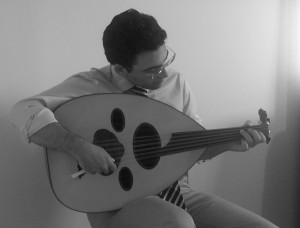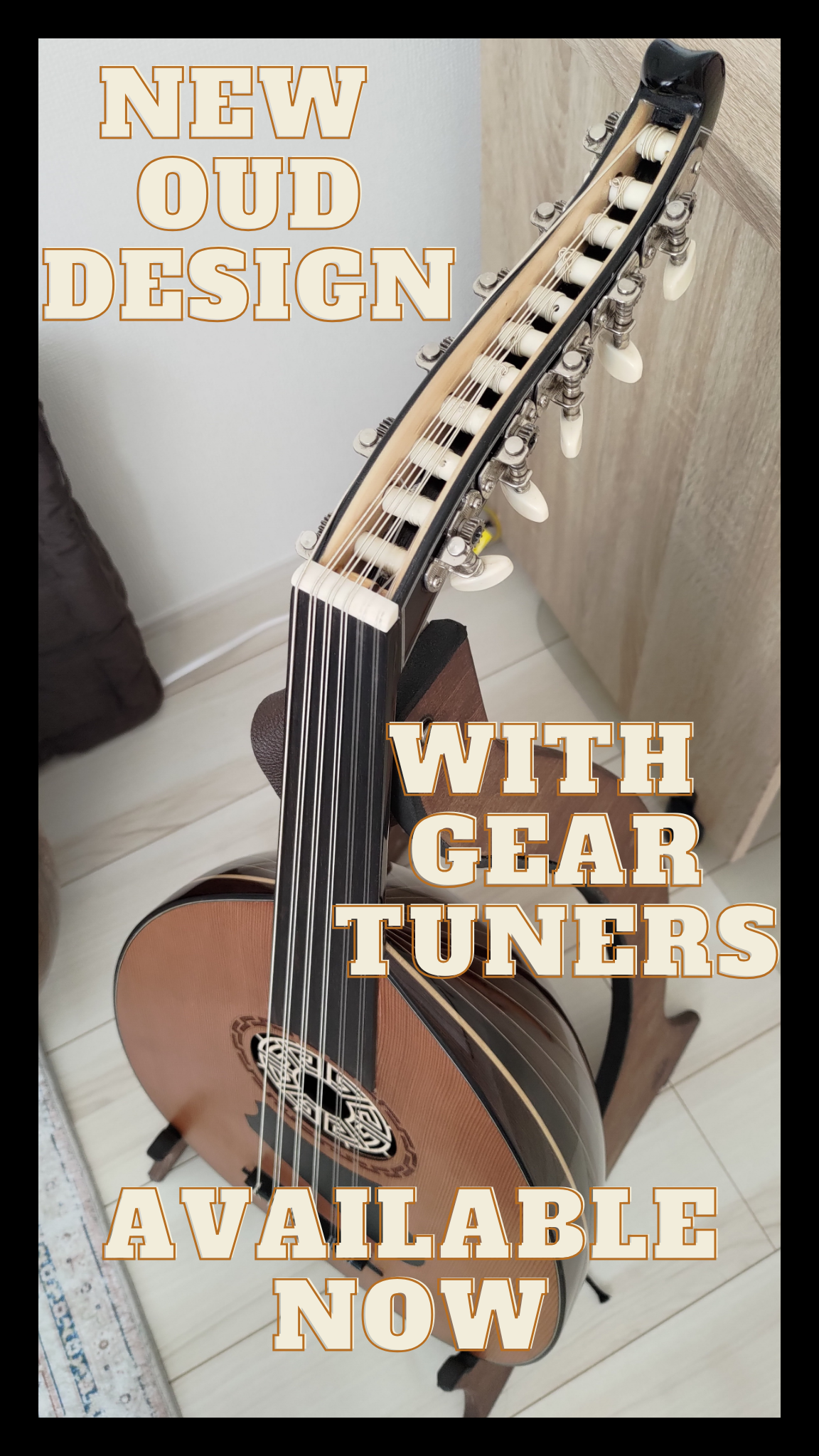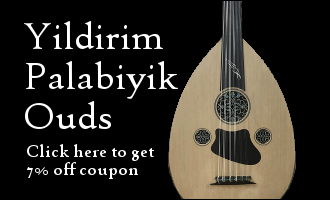This article will address some of the specific issues beginners have with their Ouds that determine how and why their Oud sounds the way it does. Some of these things may not be necessarily ‘bad’ things, but may explain why you are not hearing a particular sound you may be hearing in recordings of different Oud players.
1.) Tune that puppy up.
Most Ouds have 5 paired strings and one single bass string. So in order for the Oud to sound ‘good’ you must tune these paired strings precisely. It doesn’t matter what tuning you are using, they have to be tuned in unison.
 You may find those pesky friction tuners very difficult to tune to precision. It takes some patience. Hopefully your tuners are in good working condition. If they are stuck or too loose it can cause unreliable tuning and cause you to spend too much time tuning and not enough time playing and having fun. If you think your tuning pegs are in need of repair, try taking your Oud to a local Violin Luthier and see if she can replace your tuners. Oud tuning pegs are similar to tuning pegs in the Violin family.
You may find those pesky friction tuners very difficult to tune to precision. It takes some patience. Hopefully your tuners are in good working condition. If they are stuck or too loose it can cause unreliable tuning and cause you to spend too much time tuning and not enough time playing and having fun. If you think your tuning pegs are in need of repair, try taking your Oud to a local Violin Luthier and see if she can replace your tuners. Oud tuning pegs are similar to tuning pegs in the Violin family.
I had a situation where my brand new Oud was adjusting to different climate. Moisture in the air causes wood to expand as it absorbs the moisture in the air causing one of my ebony tuning pegs (ebony or rosewood make excellent tuning pegs) to expand enough to get stuck. In an attempt to loosen and remove the peg I damaged the peg making it unusable. I took it to a local Luthier who shaped me a new tuning peg.
When tuning your Oud you will probably begin by taking out an electronic tuner and tuning every note with the tuner, this is okay at first. But keep in mind that your tuner is going to make your Oud in tune with ‘equal’ temperament. What really makes your Oud sing is when it is played in ‘Just’ temperament. In order to achieve this, first take your tuner and tune the top high string of your Oud. Turn off the tuner and tune your next note a perfect fourth below the first note. Do the same with the next note and so forth until you reach your bottom two strings. For these two strings you will need to determine how to tune it in relation to your other open strings. Tuning your Oud in this fashion will greatly improve your ear.
2.) Make the Right Hand Right
Right hand technique is definitely going to help your Oud playing sound good. I aim for a nice clean sound. To do this I try not to allow my Mizrab to hit the pick guard very much, or at least create too much noise from it. Some noise is also good, and even the preferred sound for some Oud players, but too much can get in the way of allowing the pure sound and your melodies to come through.
The area of hitting the string is also important. Playing too close to the bridge or too close to the sound hole creates a different sound. When you play too close to the sound hole the strings have less tension in that area causing them to vibrate too much which muffles and blurs the sound. When you play too close to the bridge it creates a very sharp sounding attack because the string tension is higher in this area. So the best thing is to create a balance and play right over the pick guard. This is the most ideal area to play over. In most cases, the pick guard is actually closer to the bridge than it is to the sound hole, and this is fine. When you become more experienced, you can experiment with the different sounds created by strumming different locations. Always remember to be purposeful in the sound you want to create. Be aware of the sound you are creating, and you will be a happier player.
3.) It’s a Bird, it’s a Plane… no it’s a Turkish Oud.
If you own an Arabic Oud and you listen to a lot of Turkish Oud playing, don’t expect yourself to recreate the sound you are hearing. Turkish Ouds are very different beasts.
The first thing about the Turkish Oud is that it is tuned a whole step higher than the Arabic Oud, which contributes to a brighter sound along with higher string tension.
The nut of the Turkish Oud is also very low which creates lower action and in most cases a bit more buzz which goes along with lower action. The nut of the Arabic Oud still allows for low action but does not buzz as much but creates a clearer sound.
Oud builders can correct me here but from what I have heard about soundboards is that the soundboard of the Turkish Oud is also very responsive and thinner than Arabic Ouds, creating more sustain and brighter tone. The sound that you want to achieve from Arabic Ouds is that of a nice clear round sound with very low sustain. Sustain is undesirable in Arabic Ouds. The different sounds that each Oud makes is very subtle and must be heard in person to fully appreciate the differences.
Floating Bridge Ouds
Floating bridge Ouds have a bridge similar to most Mandolins and Irish Bouzoukis. The Iraqi Oud of Munir Bashir is the most iconic of these Ouds. The sound these Ouds produce is very different from both Arabic and Turkish Ouds. Usually more middle frequencies are highlighted and some say this Oud sounds more like a guitar because of this. You must decide for yourself. Personally, I really like the sound. To each their own.
4.) Oud is Made Out of Wood
There are many different tone woods that are used in the building of Ouds. These all have an effect on how your Oud will sound. No Oud is created equal, and no two Ouds are alike.
5.) It Always Takes a Bit of Time
Ouds sound very bright and tight when newly built. The sound of your Oud will change over time. It also depends on how often you play it. Create a relationship with your instrument. Give it the attention it needs and it will give back.
And don’t forget, Ouds need an oil change once in a while… and by that I mean a string change…
6.) Give Your Oud Some Nice Strings
I am a big fan of Aquila strings… but that’s just me. They are called nyglut strings, and they claim to create the superior sound qualities of gut strings without the limitations of gut strings. I like the warm sound they produce. But another may prefer the sound nylon strings produce. It is mostly a matter of preference.
Learn How to Change Your Strings
I don’t change my strings too often. I prefer a warmer sound, so I like broken in strings. Eventually, they will need to be changed. When you do, make sure to buy the right strings for your Oud. You do not want to put Turkish strings on an Arabic Oud and vice versa. Putting the wrong gauge strings on your Oud can cause damage. Fortunately, most string manufacturers indicate Turkish vs Arabic tunings. You should buy the strings that correspond to your Oud.
So, what do you think? Did any of the above tips improve the sound of your Oud? Let us know in the comment section below.






WONDERFUL!! NAVID THIS IS WHAT I’VE BEEN LOOKING FOR. IS COMMENT GOING TO BE SHARED AS A GENERAL POSTING? I’D RATHER EMAIL DIRECTLY TO YOU. I HAVE A FEW QUESTIONS REGARDING YOUR PROGRAM….I’LL WAIT FOR YOU ANSWER. MORE THAN LIKELY I’LL BE SIGNING UP!! THANKS MIKE
Feel free to email us at support@oudforguitarists.com. Thanks Mike.
The soundboard on my turkish oud has a slight dip about 1/8th of a inch between the bridge and the middle of the two small sound holes. Is this somewhat normal on turkish ouds or do I need to do something about it. As far as I can tell the oud plays fine and the only problem is some occasional buzzing on the fourth course!
The soundboard on my turkish oud has a slight dip about 1/8th of a inch between the bridge and the middle of the two small sound holes. Is this somewhat normal on turkish ouds or do I need to do something about it. As far as I can tell the oud plays fine and the only problem is some occasional buzzing on the fourth course!
This should be fine. All Ouds eventually change shape over time and this is normal. As long as the action isn’t too high then it’s all good. As for the 4th course, check the fingerboard for wear, our fingers also create dips and grooves and change how the string is held down by your finger. If this is the case, you should take your oud to a violin repair place and ask them to dress the fingerboard.
We will sale oud peg,oud bridge,oud peg box. So i will make our work. My mail is
info.amviolin69@gmail.com